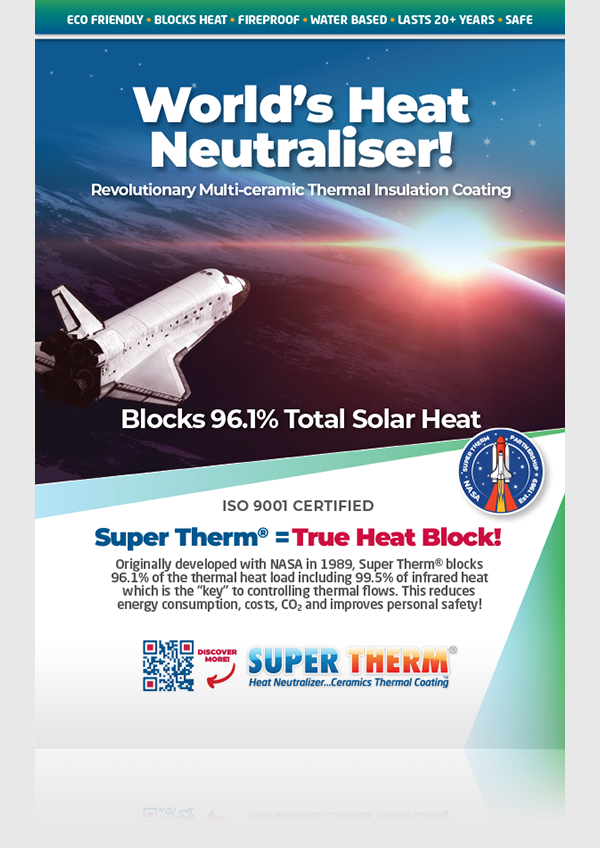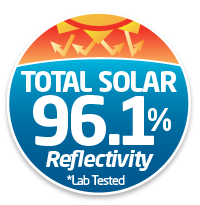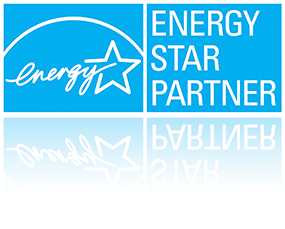Solar Panels Heat Up Cool Roofs
The Hidden Thermal Load No One Knows or Talks About
In the race to decarbonise buildings and improve energy efficiency, solar panels are often seen as a no-brainer. Clean energy from the sun, reduced electricity bills, and a visible symbol of environmental progress. But in the drive to electrify everything, one crucial factor is being overlooked: solar panels themselves can increase roof heat load—even on cool roofs—and the problem is hiding in plain sight.
That is, until you apply Super Therm®.
A Cool Roof That Exposes the Truth
Super Therm® is a high-performance solar heat block insulation coating, developed in collaboration with NASA and independently tested to block 96.1% of total solar heat, including 99.5% of infrared radiation. When applied to roofs, Super Therm® lowers the surface temperature dramatically—often to within 1–2°C of ambient air. This is not reflectivity alone; this is genuine thermal resistance at the surface, stopping heat before it enters the structure.
And that’s when the hidden story unfolds.
On an unprotected roof, everything absorbs and radiates heat—the metal, the sheeting, the solar panels, and the aluminium frames. The entire roofscape becomes uniformly hot, masking the source of heat. But once Super Therm® neutralises the solar impact on the roof, the temperature contrast is undeniable:
- The coated roof remains cool.
- The solar panel frames, rails, and extrusions remain hot—20°C or more above ambient.
- That heat doesn’t just stay in the metal—it radiates back down toward the roof surface.
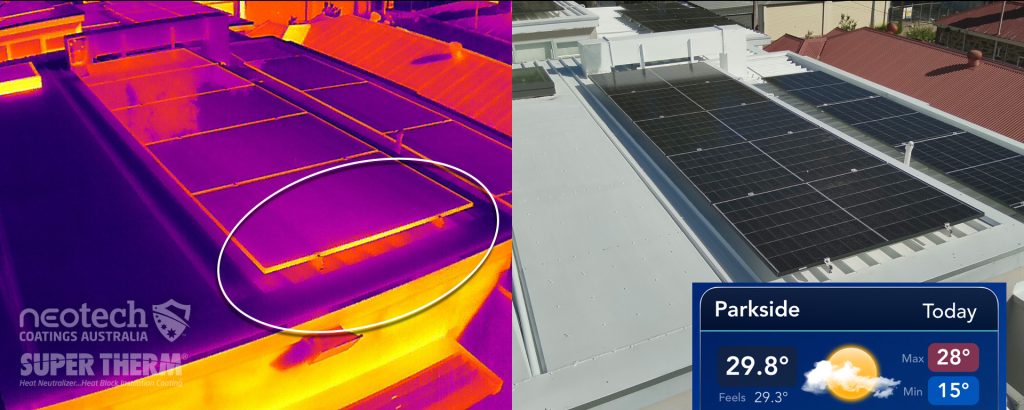
The Re-radiation Effect: A New Layer of Thermal Load
Solar panels are widely believed to shade the roof and reduce thermal gain. But the aluminium framing around most PV systems absorbs and stores solar radiation extremely well. Aluminium is a superb thermal conductor—fast to heat, fast to radiate.
Once heated, these components behave like heat lamps, radiating longwave infrared heat back down to the surface directly beneath them. This reradiated energy contributes to:
- Thermal bridging, especially around mounting fixings
- Increased internal heat load, particularly in summer
- Strain on HVAC systems, despite the presence of renewable generation
- Undermining of cool roof performance, even with high-performance coatings
This is especially problematic when designers or energy consultants assume shading from solar panels is purely beneficial. In practice, this assumption ignores the thermal feedback loop created by high-temperature aluminium hardware suspended just inches above the roof.
The Shade Fallacy of Solar Panels
It’s often claimed that solar panels “shade” the roof, reducing heat load. But here’s the problem: shade doesn’t equal cooling—especially when the object doing the shading is a hot metal structure.
On a standard roof, everything is hot, so the panel’s re-radiated heat blends in. But when you apply a high-performance coating like Super Therm®, the truth is exposed. Infrared images show it clearly:
- The roof stays cool
- The panels glow with heat
- That heat is projected downward, back onto the roof surface.
Aluminium framing and panel backs can reach 60–75°C, creating a new layer of thermal load—right where you thought you had shade. It’s not shading—it’s reradiating. Without thermal insulation like Super Therm®, your panels aren’t helping your roof. They’re silently heating it.
What the Research Says
Several peer-reviewed studies and lab observations back this up:
- NREL and other institutions have acknowledged the rooftop heat island effect under PV panels, where re-radiated heat becomes a measurable source of thermal gain.
- Barron-Gafford et al. (2016) observed that photovoltaic panels altered energy balances on rooftops, often leading to increased longwave radiation at night and thermal storage during the day.
- A 2018 UC San Diego study found that rooftop PV systems trapped heat underneath the arrays and increased the roof surface temperatures due to reradiated and convective heat.
- ASU research has shown that rooftop panels can change the thermal emissivity of a roofscape, leading to increased heat stress without proper passive design.
In each case, the presence of PV panels altered the thermal behaviour of rooftops—but this effect is only clearly revealed when the roof is first neutralised with a coating like Super Therm®.
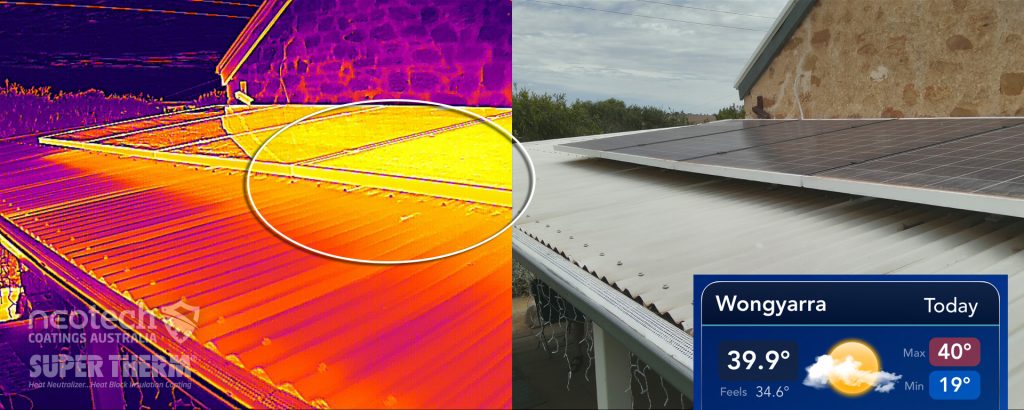
Super Therm®: Not Just a Heat Blocker—A Truth Revealer
Most insulation solutions are passive—they attempt to slow down the heat after it’s already entered the building. Super Therm® takes a different approach: it stops the heat at the surface, preventing solar load from entering at all. And in doing so, it reveals the invisible thermal layer caused by solar panel systems.
Let’s be clear: solar energy is essential for a sustainable future. But adding solar panels without addressing their thermal interaction with the building envelope is like installing a heater over your insulation. The panels generate electricity, yes—but they also radiate heat back into your roof if you haven’t taken steps to manage that effect.
And without Super Therm®, you might never know.
Visual Proof and On-Site Observations
Infrared scans of buildings coated with Super Therm® reveal the contrast starkly. In field installations:
- Roof sections under solar panels can show 20°C+ higher surface temperatures than adjacent open roof coated with Super Therm®.
- Mounting rails act as thermal bridges, transferring heat directly through roof fixings and into the internal ceiling cavity.
- These effects persist year-round but are especially problematic during heatwaves and extreme temperature spikes.
On standard roofs, this issue is invisible—the whole roof is already hot. But Super Therm® creates a controlled thermal environment, exposing the added heat load for what it is.
Your Solar Strategy Needs a Thermal Strategy
The message is simple: solar panels don’t make your building passive. They generate clean power, but they can introduce a secondary layer of heat if you don’t insulate the envelope properly.
Pairing solar with Super Therm® isn’t just good design—it’s critical. You get:
- True heat block insulation at the surface
- Minimised reradiated heat impact
- Enhanced building comfort and energy efficiency
- Extended life of roof membranes and HVAC systems
Conclusion: Don’t Let Solar Panels Work Against Your Roof
In a climate where heat extremes are rising and energy demand is peaking, every surface matters. If your solar panels are unintentionally increasing heat load, you’re compromising the very efficiency you’re trying to achieve.
Super Therm® doesn’t just block heat. It reveals truths about your building’s thermal performance that other materials can’t.
If your roof is cool but your panels are still cooking—it’s time to rethink your solar strategy such as painting the aluminium edges in Super Therm to reduce that additional heat load.
Related: Solar panels work best on cool roofs with Super Therm®






